- Steven Soderbergh, from the Making "Che" documentary, DVD 3

Few people have earned the level of respect I hold for Steven Soderbergh. When I first saw Che, the director had brought the roadshow version to Portland's Cinema 21, answering audience questions after a marvelous marathon showing of the movie in full. I've met plenty of people whose art inspired me over the years, and I usually have no problem keeping my cool. When I met Soderbergh, I got nervous and twitchy. My voice shook as I handed him a copy of one of my books
I have a feeling that Steven Soderbergh is also someone who still hangs on to his fantasies. The audacious creativity he shows from film to film leaves little doubt he dares to dream. In a way, he's a throwback to the directors who came up through the studio system in Hollywood's Golden Age, guys who never knew what their next assignment would be. Like how Robert Wise's first two movies were a historical drama and a horror movie, followed eventually by film noir, a boxing movie, comedies about oil lobbyists, war stories, corporate intrigue, and eventually some of the most popular musicals of all time. The difference is that Soderbergh has cinematic history to back him up, and he not only jumps around from subject to subject, genre to genre, but he picks and chooses what time frame he wants to emulate. Out of Sight
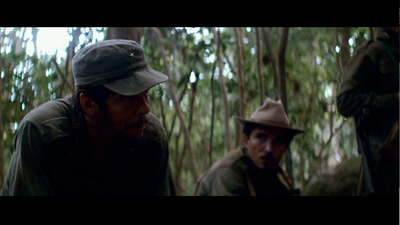
There are few filmmakers who would undertake a four-and-a-half hour, two-part biography of Che Guevara, insisting that it be filmed in Spanish to make it more authentic. Which came first? Soderbergh's mad plan or the jokes about Vincent Chase wanting to do the same thing to make Medellín on Entourage? At one point, Vinnie was even going to be replaced in the role of Pablo Escobar by Benicio Del Toro.
Che turned out better for Soderbergh than Vincent Chase's film did for him, even if it wasn't a huge box office hit. (Though, given Soderbergh's cross-platform release, making the movie available through cable on-demand services at the same time it toured theatres, it probably did better than most folks think.) It's doubtful anyone involved with Che set out to make it thinking it was going to make massive money. This is a movie like Warren Beatty's Reds, one that was made precisely because it was such an artistic gamble. It's something that both filmmakers needed to do, consequences be damned.
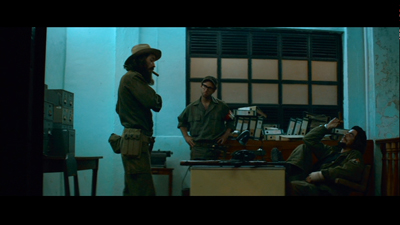
Beatty and Soderbergh likely looked back at the same influences when they made their films (and who knows, Soderbergh might have actually looked to Reds). Namely, I see Che as a modern political epic on par with the big movies of David Lean. In particular, Lawrence of Arabia
Part I of Soderbergh's film is the story of Ernesto Che Guevara's part in Fidel Castro's overthrowing of General Batista and claiming revolution in the name of the Cuban people. Benicio Del Toro starts the movie as the clean-shaven doctor joining the political cause, and he ends it as the hairy guerilla fighter immortalized on a million T-shirts
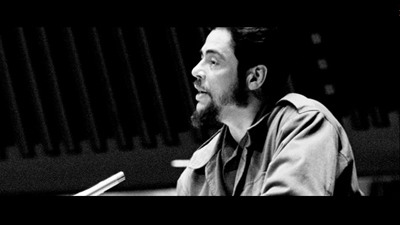
There is another major difference, though this one perhaps unintentional. The New York scenes are shot in an almost cinema-verite style, more loose and off the cuff. It's possible that Soderbergh is making a kind of cinematic pun, using the free-floating shooting techniques of the French New Wave, matching their filmic revolution to Che's political revolution. By contrast, the colorful Cuban scenes are more traditionally choreographed, with the camera often rooted in one spot. The Santa Clara sequence in particular looks and moves like an old-school battle scene, like something out of a John Sturges movie. Efficient, business-like, but still full of tension.
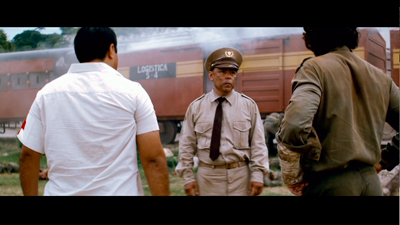
Che was the first movie to be shot entirely with the RED One Digital Cinema camera, and the device freed Soderbergh--who shoots his own films under the name Peter Andrews; also, look for him briefly as the television director when Che is getting interviewed for "Face the Nation"--to experiment and change his style and have it flow seamlessly from one look to the next. Part I of Che is shot in the very wide aspect ratio of 2.35:1, just like a big budget color movie from the 1950s or '60s, whereas Part II is a more restrained 1.78:1. This is meant to illustrate the nature of the two sides of the story. The Cuban campaign is large, full of promise, and triumphant; the Bolivian offensive is cramped, dirty, and ultimately a failure. Che spends most of the time trapped in a forest, unsure of how to get out, and so the screen boxes him in, as well. The color palette even changes. Part II is dirty, brown, and gray; it's sickly and sun-bleached.

Benicio Del Toro plays Guevara as an enigmatic, distant creature. He is kind of the quintessential Del Toro character, actually, as Del Toro's natural presence tends to put him a step or two removed from the audience. Many remember him first seeing the actor as the indecipherable Fenster in The Usual Suspects
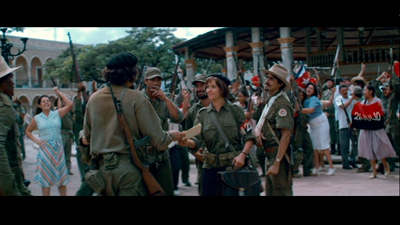
Throughout the first half, Del Toro's Che is a purposeful speaker. He is nearly humorless, completely dedicated to his mission, dogmatically so. He doesn't travel across the Cuban countryside as a warrior so much as he comes across as a missionary, a holy man ready to spread the gospel. As Soderbergh shows him, he talks his way toward Havana, be it convincing the peasants that he has come to help, motivating his troops, or negotiating with enemy officers. Some have complained about this saintly portrayal of the man, believing any film that doesn't get into the atrocities he committed toward his political enemies could never be an accurate depiction. To get into that period of Guevara's career, however, would probably require a third part to the movie, one that would sit uneasily with these two.

The way I see it, Soderbergh, Buchman, and van der Veen weren't concerned with the right or wrong of Guevara's mission. They aren't taking any sides. In fact, you could say they abstract the character to make him the mission and nothing more. Che in this movie comes to embody the revolutionary impulse, the living icon, more than just a face on a shirt. His entire life becomes about the next liberation. Part I of Che ends by flashing back to the portentous first conversation with Castro, where he agrees to join the cause if Fidel (played here by Demian Bichir) promises he can take the fight to all of Latin America once they have freed Cuba. Part II is then the portrait of a man whose single-mindedness takes him too far off the rails. He subsumes his own identity to the socialist ideal. In the opening scenes of Part II, we see Che in disguise, renouncing his Cuban citizenship (if in gesture only) and heading to Bolivia, not just unrecognizable to us, but also to himself. He is a personality in crisis.
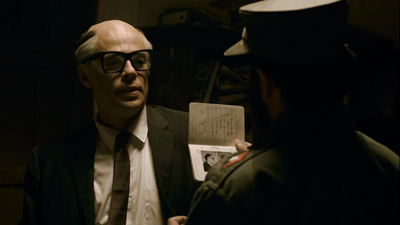
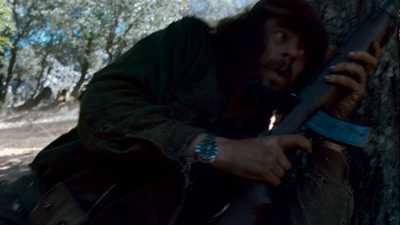
Che spends almost a year, 1966 through 1967, wandering around in the Bolivian jungle, sinking further into the morass of his own idealism. The hubris of righteous belief is taking for granted that everyone else will get on board; the Bolivians do not. The man seems to retreat into himself. He goes by a different name, never allowed to be who he really is, and his asthma all but knocks him down. The motivational speeches are almost entirely gone, there is no more of the smooth-talking rebel. Del Toro physically transforms himself, letting his hair and beard grow long, changing his posture to be more hulking. Che has been turned into a freakish outcast. By the end of the movie, his myopia has so overtaken him, we are literally looking through his eyes.
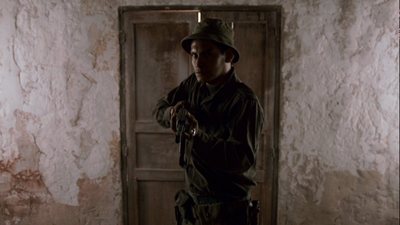
Part II is so mired in disappointment and failure, I am not sure there is any way for Soderbergh to keep it from dragging. The endless trek through the jungle starts to look the same after a while, which puts us in the shoes of the soldiers, but it may also put some people off. The Bolivian troops are a lot more anonymous than the Cuban rebels Che commanded. We don't get to know them, there aren't the distinct personality types. In Cuba, we had the teenagers who grew up in the rebel army, we had Little Cowboy and his cowboy boots, we had Che's fellow officers, who teased and joked with him, and we also had Aleida (Catalina Sandino Moreno from Maria Full of Grace
Che ends with a brief shot of Guevara back on the boat that first carried him into Cuba, reminding us of the youthful promise he once represented, but now colored by all that has followed it. In this last shot, Del Toro somehow looks older, and he now appears pensive. It's a reminder of how far we've come, from that point until now, and the way we see Che is with a new perspective. He has become a man on a collision course with destiny, and we are left to wonder if it was all worth it. The hope of yesterday dies amidst the deluge of too many tomorrows.
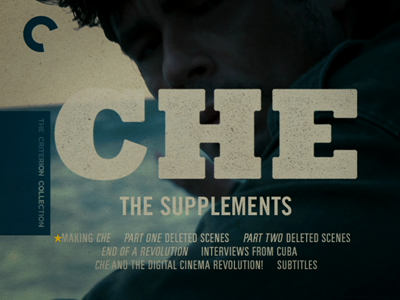
Criterion's release of Che is a three-disc set, packaged in one of their beautiful booklet-style boxes, featuring Eric Skillman's trademark photo illustrations. Each part of the movie is given its own disc, and the third disc is all supplements. The thrust of the extras is history--the history of the production and the history behind it. The film and its winding path from conception to completion is covered at length in a 50-minute making-of documentary. Those curious about how Che came about and why the production team made the choices they did will be more than satisfied by this lean, forthright peek behind the curtain. Even the criticisms the film's detractors leveled at Che are addressed. There is also a separate documentary about the use of the RED One camera that should please tech heads. Soderbergh even touches on the fact that Che the man was considered a cold personality, and addresses my query regarding the tone of the movie: he wanted Che the film to be chilly like Che the man.*
The commentary for both movies is by Jon Lee Anderson, the author whose biography Che Guevara: A Revolutionary Life

There is a deleted scene from Part I where Che tells one of his men that he needs to build a hospital in a remote area. The man asks how, he doesn't have the supplies. Che, unbending tells him to figure out a way. This small scene encapsulates the figure: he saw what needed to be done and never wavered from the conviction that it could and would be done. Whatever it took, he'd figure it out. That was how he lived, and that also embodies this production. Against all odds, the people behind Che figured it out. They saw a movie to be made, and they got it done.
And for the record, Che's score on Rotten Tomatoes is currently at 62%.
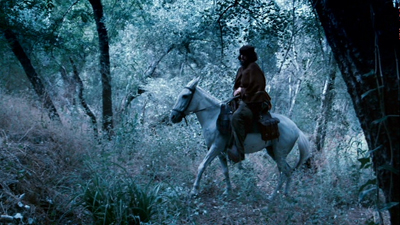
* As a glimpse inside my process, I always nail down the body of my review before I watch the extras so as to formulate my own opinions free of the influence of others. So, in a case like this, if I have a question that is answered in a bonus feature, I really did ask it and try to wrestle with it myself before stumbling on the revelation. That said, Soderbergh also mentions John Sturges, and so it makes me think that Sturges came to mind for me because the director must have also mentioned that influence when I saw him speak last March.
This disc was provided by the Criterion Collection for purposes of review.

No comments:
Post a Comment